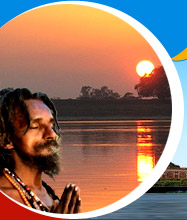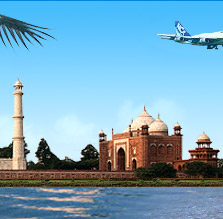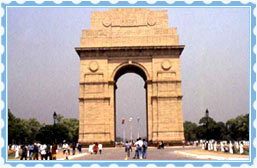 The
Capital of India, Delhi has been a political centre stage for centuries
and has passes through the hands of Hindu Rajputs to the mighty Mughals
and then to the British invaders who ruled India for long. The well
planned and sophisticated European-style buildings, gardens and wide
roads are attributed to the later period. The rich architectural,
historical and cultural heritage of the city is said to be more than
2500 years old. Chauhans ruled it in the 12th century but since
Qutab-ud-din Aibak laid siege on the city, it was ruled by Delhi
Sultanate from 1206 to 1526 and then, by the Mughal empire until 1857.
British dethroned Delhi as being the capital of India until 1911 though
it was important commercial centre and constructed a better twin sister
to the city called the New Delhi, which houses most of the important
administrative buildings today.
The
Capital of India, Delhi has been a political centre stage for centuries
and has passes through the hands of Hindu Rajputs to the mighty Mughals
and then to the British invaders who ruled India for long. The well
planned and sophisticated European-style buildings, gardens and wide
roads are attributed to the later period. The rich architectural,
historical and cultural heritage of the city is said to be more than
2500 years old. Chauhans ruled it in the 12th century but since
Qutab-ud-din Aibak laid siege on the city, it was ruled by Delhi
Sultanate from 1206 to 1526 and then, by the Mughal empire until 1857.
British dethroned Delhi as being the capital of India until 1911 though
it was important commercial centre and constructed a better twin sister
to the city called the New Delhi, which houses most of the important
administrative buildings today.Today, Delhi is an ever-expanding metropolitan city, an important travel and commercial hub of India and can boast of several sprawling markets and the rich culture that has all the ingredients from the modern sophistication to more casual old-world charm. Today, people from all over India migrate to Delhi to look for better career and education options and medical facilities and thus, people of different religions and regions have learned to live together in perfect harmony and freely partake in each other's festivals. There is no limit to tourism options in Delhi but the highlights are the Lotus Temple or Bahai Temple, Humayun's Tomb, India Gate, Qutub Minar, Jantar Mantar, Rashtrapati Bhavan (from outside), Red Fort, Raj Ghat, Shankar's International Dolls Museum, National Museum of Natural History, Nehru Memorial Museum, Planetarium & Library, and National Rail Museum.
Delhi's Prime Attractions
Qutab Minar:
The tallest structure of its time, Qutub Minar was 72.5 m in height with a mosque at the base. It was started in 1199 by a Qutab-ud-din Aibak and finished by his heir IItutmish. The 5th century Iron Pillar of Mehrauli standing in its premises is a wonder for it has not rusted till yet and is a proof of the advanced metallurgy of the times. It is said that if one can hug the pillar backwards, his or hers any wish is granted, however, tourists are not allowed to do so. People are also not allowed to climb up the Qutub Minar for there have been many cases of suicide attempts from here. The structure is surrounded by several ancient ruins that are shrouded in the mystery of myths and legends.
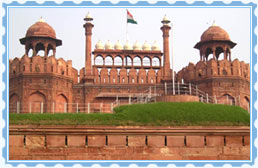 Red
Fort:
Red
Fort:The best of all the structures in Delhi, Red Fort or Lal Qila is an imposing and huge red sandstone structure built on the shores of River Yamuna and was built by. Shah Jahan when he shifted his capital from Agra to Delhi. Completed in 1648, its two main entrances are Delhi Gate and Lahori Gate. The latter opens up in the famous Chandni Chowk market. The fort houses an archeology museum, Diwan-e-Am or Hall of Public Audience, Diwan-e-Khas or Hall of Private Audience along with several structures with specific purposes. The 'Sound and Light Show' held here every evening in both Hindi and English languages is a must-see and narrates the history of Delhi with most beautiful performances.
Jama Masjid:
Jama Masjid, the largest mosque of India, was built by Shah Jahan. Started in 1650, it took six years and more than 5000 workers to complete. The emperor and his courtiers used to to go to the mosque every Friday for the congressional prayers. The splending Mughal period structure of the mosque has three massive gateways, the eastern one being the largest and the highest, reserved for the the emperor. The red stone courtyard sprawls across 408 square feet and has a large marble tank in the center for ablution. The three onion shaped white marble domes adorn the main mosque and are inlaid with stripes of black slate. 130 ft high minarets on the north and south of the mosque complex look quite beautiful. Jama Masjid the sacred hair from beard of the Prophet and the original chapter of the Holy Quran written by Him.
Raj Ghat:
The memorial of the Father of The nation, Mahatama Gandhi stands at the place where he was cremated and consists of a simple square platform with the words 'Hey Ram' written on it. The Gandhi Memorial Museum nearby displays books and tapes containing the writings, speeches and memories of Gandhiji. One can also visit the Shanti Vana, the memorial of Jawaharlal Nehru, the first Prime Minister of India and Indira Gandhi, his daughter and the first and only women Prime Minister of India. There are memorials for her sons Rajiv Gandhi and Sanjay Gandhi too, who were prominent political leaders of India.
National Zoological Park:
The biggest and finest National Zoological Park of South Asia, Delhi Zoo was established in 1959. It is an open-air enclosure and its huge cages cover the area of 214 acres, where more than 2,000 animals from varied species have found a safe haven. It is the topmost favorite picnic spot, especially for kids.
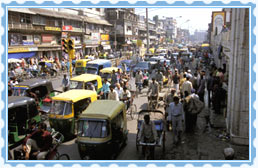 Chandni
Chowk:
Chandni
Chowk:Besides the Red Fort, Shah Jahan's favorite daughter Jahanara designed the shopping area of Chandni Chowk that was built in 1650 opposite the Lahori Gate of the fort. The 'chowk' means 'square' and had a pool in the center that reflected silvery light called 'chandni' of the moon on the moonlit night thus earning the name of 'Chandni Chowk' to the area. Other believe that it was so called because of the silversmiths that originally occupied the area. The original arcade was built in a half-moon shape and has evolved now to a flourishing trading center that branches into a number of narrow bylanes in all directions. It is a must visit for the most fulfilling shopping experience and some real good bargains.
Jantar Mantar:
With large masonry tools, Jantar Mantar is an observatory built by the ingenius designs of Raja Sawai Jai Singh II of Jaipur (1699-1743), an honored noble in the Mughal court. Sawa Jai Singh was a keen astronomer and made huge achievements in the field by designing accurate tools to correct the existing astronomical tables and contemporarize the almanac. The observatory in Delhi is first of the five built by him. The others were built in Jaipur, Varanasi, Ujjain and Mathura. The most famous tools here are the Samrat Yantra, an equal hour sun dial, the Ram Yantra that reads altitudinal angles, Jai Prakash Yantra used to check the position of the sun and other celestial bodies and the Misra Yantra, which had the qualities of all the scientific gadgets mention above.
Humayun's Tomb:
His Persian widow, Haji Begum, designed the UNESCO World Heritage site, the garden tomb of Humayun, in the mid-16th century. It is said to be a landmark in the evolution of Mughal mausoleums. The tomb is located centrally in a geometrically planned garden watered by a number of water channels passing throuhg it, just like the gardens of Persia. Its architecture, especially its main chamber is inspired by the tomb of the Mongol Ilkhanid ruler of Persia, Oljeytu, at Sultaniyya, which is said to be the replica of the tomb of Timur (Tamerlane) in Samarkand, the lineage of Babur. It introduced Persian double dome for the first time in India and is harmonious in its proportions. Indian influence can be seen in the small kiosks or chhatris on the roof. The beautiful inlaid tile work and intricately carved stone screens adorn the building.
Lotus Temple Or Bahai Temple:
Fariburz Sahba, an Iranian-born Canadian architect, designed the temple of the Bahai faith, Lotus temple. Erected in the shape of the flower after which it is named in 1986, it symbolizes purity. Its nine petals represent the highest digit and unity as indicated in the Bahai faith. There are nine pools too to cool the stark, elegant interiors of the structure. Its delicate and sleek architecture is built in two layers and resembles origami work. The Hall of Worship conforms to that of all Bahai temples and a pin-drop silence is maintained there at all times. The only religious icons there are the Holy Scriptures and wooden pews.
Delhi City Facts

